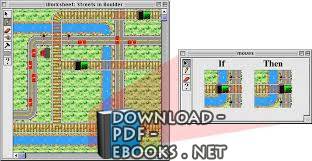📘 قراءة كتاب Programming Environments for Novices أونلاين


بيئات البرمجة للمبتدئين
Mark Guzdial
College of Computing، Georgia Institute of Technology
guzdial@cc.gatech.edu
7 مايو 2003
1 البيئات المتخصصة للمبتدئين
تبدأ مهمة تخصيص بيئات البرمجة للمبتدئين بإدراك
أن البرمجة مهارة صعبة ليتعلم.
لوحظ نقص مهارات البرمجة لدى الطلاب حتى بعد عام من الدراسات الجامعية في علوم الكمبيوتر
وقياسها في أوائل الثمانينيات [32] ومرة أخرى في هذا العقد [20]. نعلم أن الطلاب
يواجهون مشكلات في التراكيب الحلقية [31] والشرطية [8] وتجميع البرامج
من المكونات الأساسية [33] | وربما هناك عوامل وتفاعلات أخرى
بين هذه العوامل أيضًا.
ما هي القطع الحاسمة؟ ما قطع، وإذا كنا ¯xed "هم (جعلها أفضل
للمبرمجين المبتدئين)، من شأنها أن تجعل البرمجة الى أكثر قابلية للإدارة، learn-
مهارة قادرة؟ إذا وضعنا اللغة التي غيرت كيفية عمل الشرطية أو الحلقات،
أو تجعل من السهل على الاندماج المكونات ، هل تصبح البرمجة أسهل؟ هذه هي
المشكلة التي يطرحها مطورو بيئات البرمجة التعليمية. تحاول
كل بيئة برمجة مبتدئة (أو مجموعة بيئات)
الإجابة على السؤال ، ما الذي يجعل البرمجة صعبة؟ " تتضمن كل إجابة على هذا
السؤال مجموعة من البيئات التي تعالج القلق بمجموعة من
حلول. تحاول كل بيئة تمت مناقشتها في هذا الفصل استخدام العديد من
هذه الإجابات لتسهيل البرمجة على المبتدئين.
من الواضح أن هناك العديد من الإجابات على السؤال ما الذي يجعل البرمجة
صعبة؟ "لكل إجابة ، هناك العديد من البيئات المحتملة التي
تعمل على هذه الإجابة ، ومن ثم هناك العديد من البيئات المحتملة الأخرى
التي تتعامل مع إجابات على هذا السؤال. هذا ليس مفاجئًا ، لأنه من
شبه المؤكد أنه لا توجد إجابة واحدة صحيحة للسؤال الذي ينطبق
على جميع الأشخاص.
ومع ذلك ، لم يتم بناء واستكشاف كل هذه البيئات المحتملة.
مجال علوم الكمبيوتر البحث في التعليم جديد للغاية ، وهناك عدد قليل جدًا منه
الناس الذين يعملون في هذا المجال. ما زلنا في مرحلة تحديد إجابة
واحدة
محتملة للأسئلة الرئيسية | في الواقع ، حتى تحديد ماهية الأسئلة الرئيسية
!
ومع ذلك ، هناك العديد من بيئات البرمجة المبتدئة التي تم
بناؤها ، ولا يمكن مناقشتها كلها في كتاب تمهيدي قصير. بدلاً من ذلك ، سيركز هذا الفصل
على ثلاث عائلات كانت لها أهمية خاصة في تطوير
البيئات الحديثة وفي تفكير مجتمع أبحاث CS Ed.
² مجموعة لوجو لبيئات البرمجة ، التي بدأت كلغة O®-shoot
للغة البرمجة AI Lisp ونتج عنها مجموعة متنوعة غنية من
بيئات البرمجة للمبتدئين .
² عائلة بيئات البرمجة المستندة إلى القواعد ، والتي تم اشتقاقها من كل من Logo
و Smalltalk-72 ، ولكن بشكل مباشر أكثر من Prolog.
² عائلة لغات البرمجة التقليدية لبيئات البرمجة للمبتدئين
، والتي حاولت عدم تغيير اللغة ، ولكنها بدلاً من ذلك توفر دعمًا جديدًا
يركز على الطالب للغات البرمجة الحالية.
يتراوح جمهور هذه البيئات من أطفال المدارس الصغار
لبيئات Logo إلى طلاب الجامعات الجامعيين لبعض
بيئات لغات البرمجة التقليدية . في هذا الفصل ، تم تجاهل مسألة الاختلافات الطلابية
(على سبيل المثال ، العمر ، الخلفية ، الدافع). هذا تبسيط ضخم
مقبول في هذه الحالة لأن المشكلة صعبة للغاية. بغض النظر عن عمر
الطلاب ، من الصعب تعلم البرمجة. سواء حاول الطلاب تعلم
البرمجة في سن مبكرة أو في سن الشباب ، تظل المهام والصعوبات
متشابهة. تحاول البيئات الموجودة في الأقسام أدناه التعامل مع
تلك التحديات مهما كان عمر جمهور الطلاب.
2 الشعار وأحفاده: الهدف من شعار
محو الأمية الحاسوبية
تم تطويره في منتصف الستينيات من قبل والي فيوزيج وداني بوبرو في
مختبرات بي بي إن ، بالتشاور مع سيمور بابيرت في معهد ماساتشوستس للتكنولوجيا القريب. تم تصميم الشعار ليكون
Lisp بدون أقواس. "كانت Lisp لغة برمجة مشهورة للصناعة اليدوية
برمجة الذكاء. عُرفت Lisp بمرونتها وسهولة تحويل
البيانات إلى برنامج ، أو العكس ، مما يجعل من السهل جدًا على البرامج معالجة
مكوناتها. كان Lisp جيدًا بشكل خاص لإنشاء
تمثيلات المعرفة والتلاعب بها . (انظر الشكل 1 للاطلاع على شجرة العائلة في هذا القسم.)
كانت الإجابة على سؤال ما الذي يجعل البرمجة صعبة؟ "بالنسبة
لمطوري Logo ، كان سؤالًا آخر. عندما كان يتم تطوير Logo لأول مرة ، لم يكن الناس
يعرفون أن البرمجة ستبدأ أن تكون صعبًا جدًا بالنسبة للكثيرين ، كانت البرمجة لا تزال
تثير الفضول ، وهو نشاط يمارسه فقط قلة من الذين لديهم إمكانية الوصول إلى الأجهزة التي لا تزال نادرة
.
سنة النشر : 2003م / 1424هـ .
حجم الكتاب عند التحميل : 1.2 ميجا بايت .
نوع الكتاب : pdf.
عداد القراءة:
اذا اعجبك الكتاب فضلاً اضغط على أعجبني و يمكنك تحميله من هنا:

شكرًا لمساهمتكم
شكراً لمساهمتكم معنا في الإرتقاء بمستوى المكتبة ، يمكنكم االتبليغ عن اخطاء او سوء اختيار للكتب وتصنيفها ومحتواها ، أو كتاب يُمنع نشره ، او محمي بحقوق طبع ونشر ، فضلاً قم بالتبليغ عن الكتاب المُخالف:
 قبل تحميل الكتاب ..
قبل تحميل الكتاب ..
يجب ان يتوفر لديكم برنامج تشغيل وقراءة ملفات pdf
يمكن تحميلة من هنا 'http://get.adobe.com/reader/'


 منصّة المكتبة
منصّة المكتبة